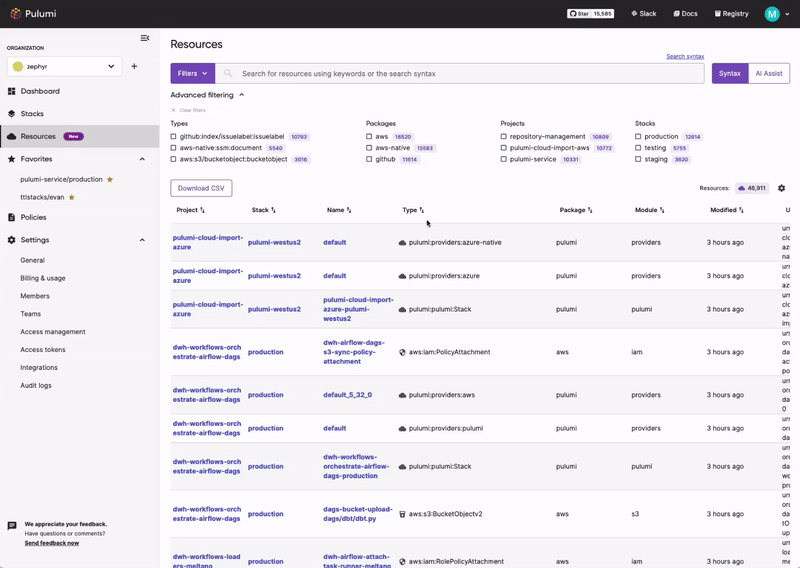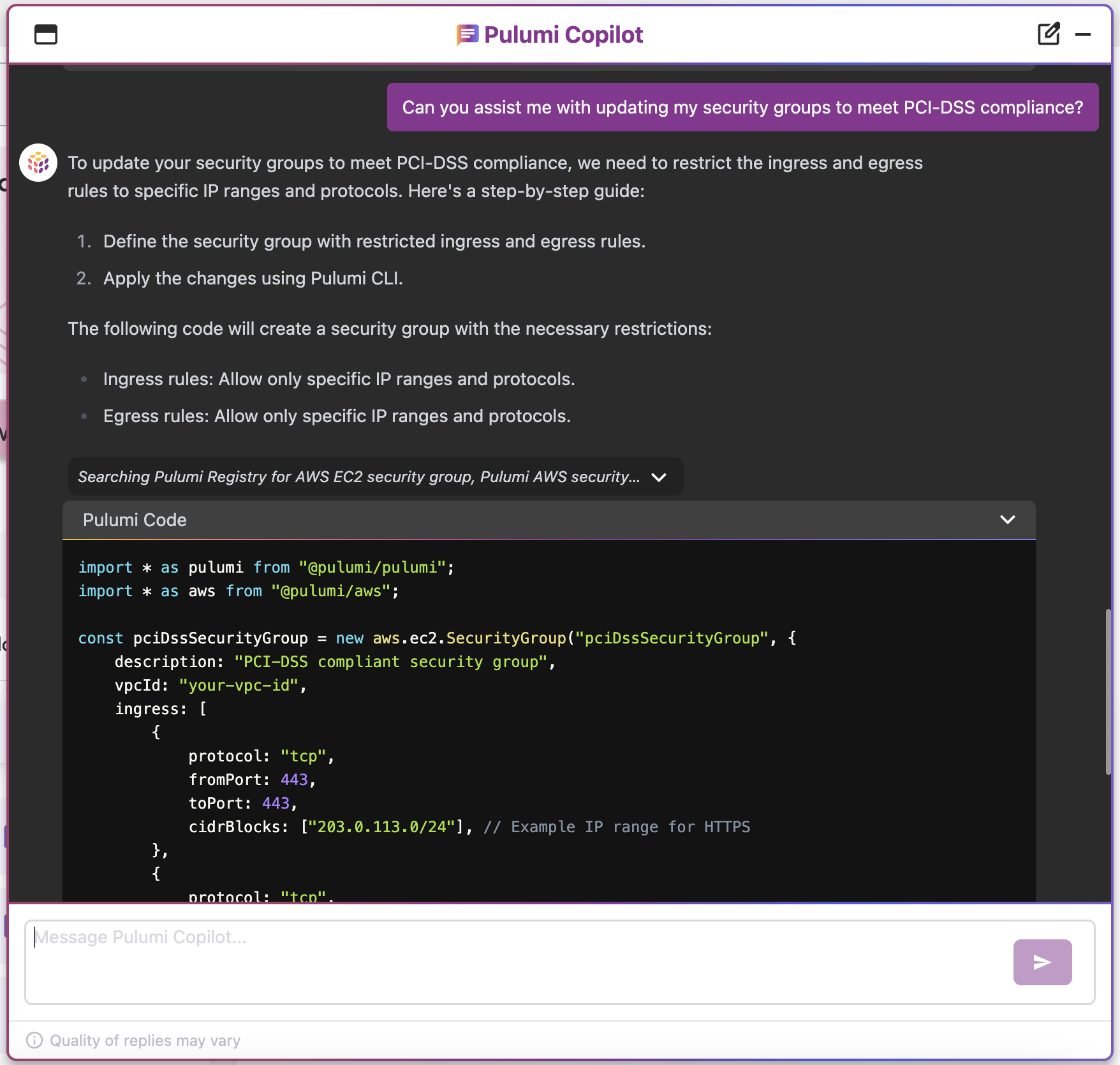ISO 27001 Compliance for Google Cloud
ISO 27001 Compliance for Google Cloud
ISO 27001 compliance is essential for ensuring the security and management of sensitive information across your organization. Pulumi can assist you in making your Google Cloud infrastructure ISO 27001 compliant. Pulumi can help you identify existing cloud resources that are not in compliance, and it can also enforce compliance policies proactively before infrastructure is deployed. Get started with Pulumi to use these compliance tools or speak with a Solutions Architect to get an expert consultation.
What is ISO 27001 Compliance?
ISO 27001 is an internationally recognized standard for establishing, implementing, maintaining, and continually improving an information security management system (ISMS). It helps organizations protect sensitive data by providing a risk-based approach, ensuring that security measures are proportionate to the risks faced. ISO 27001 is based around the following 3 pillars: confidentiality, integrity, and availability. By achieving ISO 27001 certification, organizations demonstrate their commitment to robust information security practices and regulatory compliance.
Key Aspects of ISO 27001 Compliance
- Risk Management: ISO 27001 requires organizations to assess risks related to their information assets and implement controls to mitigate these risks.
- Security Controls: The standard includes a comprehensive set of security controls (outlined in Annex A) that cover areas like access control, cryptography, physical security, and incident management.
- ISMS Implementation: Organizations must establish an ISMS, which is a systematic approach to managing sensitive company information so that it remains secure. This involves setting policies, procedures, and controls.
- Continuous Improvement: ISO 27001 emphasizes the importance of continually monitoring, reviewing, and improving the ISMS to adapt to changing security risks and business needs.
- Compliance and Certification: Organizations can seek certification to ISO 27001 by undergoing an external audit conducted by a certification body. Certification demonstrates that an organization has implemented best practices for information security management.
- Legal and Regulatory Requirements: ISO 27001 helps organizations comply with legal, regulatory, and contractual obligations related to information security.
ISO 27001 Compliance for your Google Cloud Infrastructure
To make your Google Cloud infrastructure compliant with ISO 27001, you need to align your information security management practices with the ISO 27001 standard. Below is a checklist to guide you through the necessary steps:
1. Establish an Information Security Management System (ISMS)
- Define the ISMS Scope: Determine the scope of your ISMS, specifying which parts of your Google Cloud infrastructure will be covered.
- Develop Security Policies: Create and document information security policies that align with ISO 27001 requirements, tailored to your Google Cloud resources.
- Set Security Objectives: Define clear security objectives that align with your organization's strategic goals and the capabilities of Google Cloud.
2. Conduct a Risk Assessment
- Identify Information Assets: Identify all information assets associated with your Google Cloud infrastructure, including data storage, running applications, and network configurations.
- Assess Risks: Perform a risk assessment to identify potential threats and vulnerabilities that could impact the security of your Google Cloud infrastructure.
- Risk Treatment Plan: Develop a risk treatment plan to address identified risks using ISO 27001's Annex A controls, applying them where applicable to Google Cloud services.
3. Implement Security Controls
- Access Control: Ensure that access to your Google Cloud infrastructure is restricted to authorized personnel. Use Google Cloud Identity and Access Management (IAM) to enforce least privilege access.
- Encryption: Encrypt data at rest and in transit. Use Cloud Key Management Service (KMS) to manage encryption keys, and ensure that HTTPS/TLS is enabled for secure communication.
- Logging and Monitoring: Enable Cloud Monitoring, Cloud Logging, and VPC Flow Logs to track access and activity on your Google Cloud infrastructure. Regularly review logs for suspicious activity.
- Backups and Recovery: Implement automated backups using Cloud Storage or Persistent Disk snapshots and ensure that recovery procedures are documented and tested.
4. Leadership and Commitment
- Management Support: Ensure that senior management is involved in supporting the ISMS. They should provide necessary resources and demonstrate commitment to information security.
- Define Roles and Responsibilities: Clearly define and document the roles and responsibilities of personnel involved in managing Google Cloud infrastructure and information security.
5. Awareness and Training
- Security Awareness Training: Provide regular training to personnel on information security best practices and ISO 27001 requirements specific to Google Cloud.
- Competency Development: Ensure that personnel have the necessary skills and knowledge to manage the Google Cloud infrastructure securely.
6. Operational Security
- Patch Management: Regularly update and patch the operating systems, applications, and dependencies running on your Google Cloud infrastructure using tools like OS Patch Management.
- Configuration Management: Securely configure your Google Cloud resources, following best practices like Google Cloud Security Command Center to reduce attack surfaces (e.g., disabling unnecessary services, limiting administrative access).
- Incident Response: Develop and document an incident response plan using Cloud Security Command Center. Ensure that you can detect, respond to, and recover from security incidents within your Google Cloud environment.
7. Supplier Management
- Third-Party Risks: Ensure that any third-party services you use (e.g., for payment processing or backups) are also compliant with ISO 27001 or have robust security measures in place.
- Service Level Agreements (SLAs): Establish SLAs with third-party providers that include information security requirements and ensure compliance with ISO 27001.
8. Performance Evaluation
- Regular Audits: Conduct internal audits to assess the effectiveness of your security controls and the ISMS in relation to your Google Cloud infrastructure resources.
- Monitoring and Review: Regularly monitor security metrics, review logs, and perform security reviews using tools like Cloud Security Command Center to ensure ongoing compliance.
9. Continuous Improvement
- Corrective Actions: When non-conformities are identified during audits or security incidents, take corrective actions to address them and prevent recurrence.
- ISMS Improvement: Continuously improve the ISMS by updating policies, procedures, and controls based on lessons learned and evolving risks.
10. Certification
- External Audit: Engage an accredited certification body to conduct an audit of your ISMS. The audit will typically involve a documentation review (Stage 1) followed by an assessment of control implementations (Stage 2) in your Google Cloud environment.
- Surveillance Audits: After achieving certification, prepare for regular surveillance audits to ensure ongoing compliance with ISO 27001.
11. Documentation
- Maintain Documentation: Keep thorough records of security policies, risk assessments, treatment plans, audits, and any changes to the ISMS. Use Google Cloud Source Repositories or other documentation tools to track changes.
- Security Policy: Ensure that your security policy is communicated to relevant stakeholders and reviewed regularly to maintain alignment with ISO 27001.
Pulumi Insights
Use Pulumi Insights to gain visibility into your cloud infrastructure's configuration to assess ISO 27001 compliance. Pulumi Insights is Intelligent Cloud Management. It helps you gain security, compliance, and cost insights into the entirety of your organization's cloud assets and automatically remediate issues.

Pulumi Copilot
Use Pulumi Copilot to assist configuring your infrastructure to make it compliance ready. You can tap into the Pulumi Copilot's deep understanding of your organization's context to gain visibility into the configuration of resources and assess their compliance.

Compliance Ready Policies
With comprehensive coverage of Google Cloud, Pulumi Compliance Ready Policies provide an enhanced level of control and governance over your cloud resources. Pulumi Compliance Ready Policies empower you to enforce best practices, security standards, cost controls, and compliance requirements seamlessly within your infrastructure-as-code workflows.
Compliance for Google Cloud Services
Learn more about how Pulumi can make your Google Cloud services ISO 27001 compliant.
Talk to a Solutions Architect
Get in touch with our Solutions Architects to get all your resources in use with Pulumi Insights